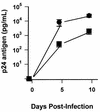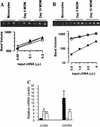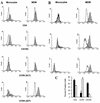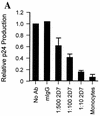Expression of CCR5 increases during monocyte differentiation and directly mediates macrophage susceptibility to infection by human immunodeficiency virus type 1
- PMID: 9573265
- PMCID: PMC110058
- DOI: 10.1128/JVI.72.6.4962-4969.1998
Expression of CCR5 increases during monocyte differentiation and directly mediates macrophage susceptibility to infection by human immunodeficiency virus type 1
Abstract
The stage of differentiation and the lineage of CD4+ cells profoundly affect their susceptibility to infection by human immunodeficiency virus type 1 (HIV-1). While CD4(+) T lymphocytes in patients are readily susceptible to HIV-1 infection, peripheral blood monocytes are relatively resistant during acute or early infection, even though monocytes also express CD4 and viral strains with macrophage (M)-tropic phenotypes predominate. CCR5, the main coreceptor for M-tropic viruses, clearly contributes to the ability of CD4+ T cells to be infected. To determine whether low levels of CCR5 expression account for the block in infection of monocytes, we examined primary monocyte lineage cells during differentiation. Culturing of blood monocytes for 5 days led to an increase in the mean number of CCR5-positive cells from <20% of monocytes to >80% of monocyte-derived macrophages (MDM). Levels of CCR5 expression per monocyte were generally lower than those on MDM, perhaps below a minimum threshold level necessary for efficient infection. Productive infection may be restricted to the small subset of monocytes that express relatively high levels of CCR5. Steady-state CCR5 mRNA levels also increased four- to fivefold during MDM differentiation. Infection of MDM by M-tropic HIV-1JRFL resulted in >10-fold-higher levels of p24, and MDM harbored >30-fold more HIV-1 DNA copies than monocytes. In the presence of the CCR5-specific monoclonal antibody (MAb) 2D7, virus production and cellular levels of HIV-1 DNA were decreased by >80% in MDM, indicating a block in viral entry. There was a direct association between levels of CCR5 and differentiation of monocytes to macrophages. Levels of CCR5 were related to monocyte resistance and macrophage susceptibility to infection because infection by the M-tropic strain HIV-1JRFL could be blocked by MAb 2D7. These results provide direct evidence that CCR5 functions as a coreceptor for HIV-1 infection of primary macrophages.
Figures





Similar articles
-
Tat protein induces human immunodeficiency virus type 1 (HIV-1) coreceptors and promotes infection with both macrophage-tropic and T-lymphotropic HIV-1 strains.J Virol. 1998 Nov;72(11):8952-60. doi: 10.1128/JVI.72.11.8952-8960.1998. J Virol. 1998. PMID: 9765440 Free PMC article.
-
Effect of RANTES on the infection of monocyte-derived primary macrophages by human immunodeficiency virus type 1 and type 2.Biomed Pharmacother. 1998;52(10):447-53. doi: 10.1016/s0753-3322(99)80023-7. Biomed Pharmacother. 1998. PMID: 9921414
-
Persistent CCR5 utilization and enhanced macrophage tropism by primary blood human immunodeficiency virus type 1 isolates from advanced stages of disease and comparison to tissue-derived isolates.J Virol. 1999 Dec;73(12):9741-55. doi: 10.1128/JVI.73.12.9741-9755.1999. J Virol. 1999. PMID: 10559284 Free PMC article.
-
The role of monocytes and macrophages in the pathogenesis of HIV-1 infection.Curr Med Chem. 2002 Nov;9(21):1893-903. doi: 10.2174/0929867023368935. Curr Med Chem. 2002. PMID: 12369874 Review.
-
Cells of the monocyte-macrophage lineage and pathogenesis of HIV-1 infection.J Acquir Immune Defic Syndr. 1999 Dec 15;22(5):413-29. doi: 10.1097/00126334-199912150-00001. J Acquir Immune Defic Syndr. 1999. PMID: 10961602 Review.
Cited by
-
Role of low CD4 levels in the influence of human immunodeficiency virus type 1 envelope V1 and V2 regions on entry and spread in macrophages.J Virol. 2005 Apr;79(8):4828-37. doi: 10.1128/JVI.79.8.4828-4837.2005. J Virol. 2005. PMID: 15795268 Free PMC article.
-
Complex determinants in human immunodeficiency virus type 1 envelope gp120 mediate CXCR4-dependent infection of macrophages.J Virol. 2005 Nov;79(21):13250-61. doi: 10.1128/JVI.79.21.13250-13261.2005. J Virol. 2005. PMID: 16227248 Free PMC article.
-
Progress toward a human CD4/CCR5 transgenic rat model for de novo infection by human immunodeficiency virus type 1.J Exp Med. 2002 Mar 18;195(6):719-36. doi: 10.1084/jem.20011549. J Exp Med. 2002. PMID: 11901198 Free PMC article.
-
Role of Chemokines and Chemokine Receptors in Rheumatoid Arthritis.Immunotargets Ther. 2020 Mar 9;9:43-56. doi: 10.2147/ITT.S243636. eCollection 2020. Immunotargets Ther. 2020. PMID: 32211348 Free PMC article. Review.
-
Properties of human blood monocytes. II. Monocytes from healthy adults are highly heterogeneous within and among individuals.Cytometry B Clin Cytom. 2014 Mar;86(2):121-34. doi: 10.1002/cyto.b.21141. Epub 2013 Dec 10. Cytometry B Clin Cytom. 2014. PMID: 24327358 Free PMC article.
References
-
- Aleixo L F, Goodenow M M, Sleasman J W. Zidovudine administered to women infected with human immunodeficiency virus type 1 and to their neonates reduces pediatric infection independent of an effect on levels of maternal virus. J Pediatr. 1997;130:906–914. - PubMed
-
- Aleixo, L. F., and M. M. Goodenow. Unpublished data. - PubMed
-
- Alkhatib G, Combadiere C, Broder C C, Feng Y, Kennedy P E, Murphy P M, Berger E A. CC CKR5: a RANTES, MIP-1β receptor as a fusion cofactor for macrophage-tropic HIV-1. Science. 1996;272:1955–1958. - PubMed
-
- Arenzana-Seisdedos F, Virelizier J-L, Rousset D, Clark-Lewis I, Loetscher P, Moser B, Baggiolini M. HIV blocked by chemokine antagonist. Nature. 1996;383:400. - PubMed
Publication types
MeSH terms
Substances
Grants and funding
LinkOut - more resources
Full Text Sources
Other Literature Sources
Medical
Research Materials

